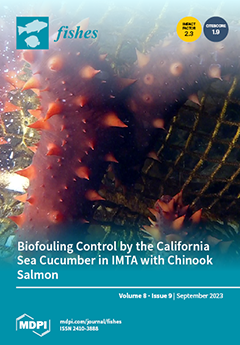The type of protein source in diets has many effects on shrimp. In this study,
Litopenaeus vannamei with an initial body weight of 3.68 ± 0.002 g were fed for 8 weeks on three experimental diets (isoproteic: 41.00%; isolipidic: 7.61%) that were formulated using fish meal (FM),
Chlorella sorokiniana (CHL), and
Clostridium autoethanogenum protein (CAP) as the primary protein sources, respectively. This study examined the growth, non-specific immunity, intestinal digestion, and microbiota of
L. vannamei after the feeding experiment concluded. Compared to the FM group, the findings indicate that the weight gain rate (WGR), specific growth rate (SGR), and protein efficiency ratio (PER) of
L. vannamei were notably enhanced via dietary CAP. The CHL group exhibited the highest levels of catalase (CAT), phenoloxidase (PO), and superoxide dismutase (SOD) activities in the gills of
L. vannamei, whereas the FM group had the lowest levels. Conversely, the malondialdehyde (MDA) content showed the opposite trend. Both dietary CHL and CAP promoted the digestive enzyme activities of
L. vannamei, with dietary CAP having a more pronounced promotional effect. An analysis of alpha diversity indicated that the consumption of dietary CHL substantially enhanced the abundance and diversity of microbiota in the intestinal tract of
L. vannamei. Furthermore, the dietary CHL significantly increased the colonization of immune-associated beneficial bacteria and inhibited the colonization of pathogenic bacteria in the intestinal tract of
L. vannamei, whereas dietary CAP mainly increased the colonization of growth-associated beneficial bacteria. Functional predictions showed that different dietary protein sources affect various metabolic activities and signaling pathways of
L. vannamei, and some functions, including signal transduction, cell motility, and the immune system, were significantly enhanced in the CHL group. In summary, both dietary CHL and dietary CAP promoted growth and immunity in
L. vannamei compared to dietary FM. The results of this study could be helpful for the sustainable development of shrimp farming.
Full article





